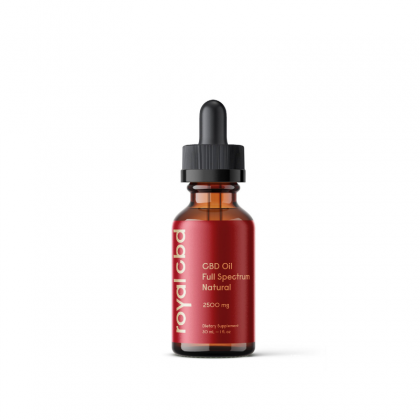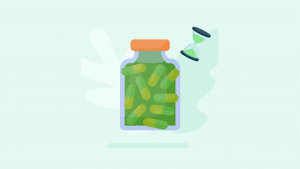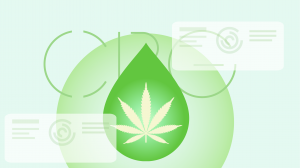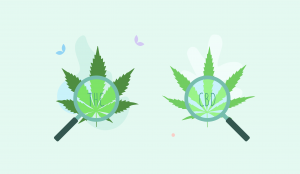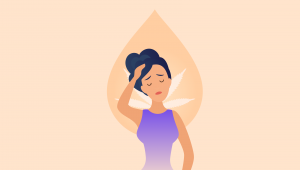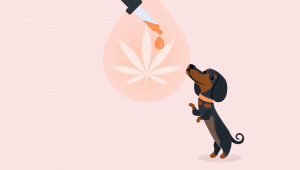| Total CBD: | 500 – 2500 mg |
| Potency: | 16.6 - 83.3 mg/mL |
| Cost per mg CBD: | $0.12 – $0.18 |
| Extract Type: | Full-spectrum |
| THC Content: | <0.3% |
Evidence based
CBD for PTSD: Benefits, Dosage, & Side-Effects
CBD may help eliminate stress & anxiety from PTSD.
Learn how it works, how much to take, and what CBD oils are most effective.
PTSD affects at least 10% of people at some stage in their life [1].
Most of us have experienced trauma in some way. It can come from many places — abuse, war, accidents, disasters, or traumatic loss. It can overwhelm and affect our ability to cope. Response to trauma can have devastating consequences.
If someone is feeling distressed, disconnected, or isolated after experiencing or witnessing a life-threatening event, they may have PTSD. Current treatment methods are often unsuccessful and some have unwanted side effects.
Recently, studies have confirmed the ability of cannabidiol (CBD), a component of Cannabis sativa to be extremely beneficial in improving PTSD symptoms.
Here, we discuss PTSD, its symptoms, and how high-quality CBD oil products can help to support trauma recovery.
Let’s get started.

Can CBD Oil Help With Post Traumatic Stress Disorder (PTSD)?
Researchers have discovered many promising benefits of CBD to alleviate the symptoms associated with the disorder — especially in people that haven’t responded well to conventional therapies.
The benefits of CBD oil for PTSD include:
- May prevent nightmares
- may prevent the formation of “fear memories”
- Alleviates symptoms of anxiety & depression
- Alleviates insomnia
1. It Stops Nightmares
Clinical Trials have shown that CBD ceased or significantly reduced flashbacks, nightmares, and persistent memories in patients with PTSD [7].
2. It Prevents The Formation of Fear Memories
CBD disrupts the feelings of long-term fear memory processing, consequently reducing stress and anxiety [8].
3. It Reduces Anxiety and Depression Symptoms
CBD has a range of calming effects that reduce anxiety, panic attacks, compulsiveness, and the long-term effects of stress [9].
4. It Helps With Insomnia
CBD improves the quantity and quality of sleep and reduces night sweats. [10]
What’s The Dose of CBD Oil For PTSD
If you’re considering trying CBD oil for the first time, it’s important to start with a small dose and increase gradually.
Dosage recommendations vary and depend on the product you choose. Use our CBD dosage calculator below to find the best dose based on your weight and desired strength.
The most common method of taking CBD oil is in the form of drops. Place the dose under your tongue where it’s easily absorbed and swallow after 30 seconds to a minute.
Studies have shown high dosage ranges from 12 mg to 25 mg of CBD can significantly decrease anxiety symptoms, taking effect within 1-2 hours after taking the oil [1].
The key is to start low and go slow.
Be patient. Keep a daily journal of dosage and track your symptoms. You’ll know you’ve reached the ideal dose when your symptoms start to improve.
CBD Oil Dosage Calculator
Endocannabinoid Dysfunction & PTSD
The two major cannabinoids found in Cannabis, tetrahydrocannabinol (THC) and cannabidiol (CBD), are both compounds that influence the body’s endocannabinoid system (ECS) but have very different effects.
Recently, researchers have focused on the importance of the endocannabinoid system as an essential emotional regulating system the body uses to maintain homeostasis — or support ‘balance’ in the internal environment despite changes in the external environment.
The ECS plays a crucial role in brain and nervous system function and is involved in modulating other factors such as appetite, sleep, pain, and cognitive function [9].
Researchers believe that chronic stress, or a traumatic event, can impair the ECS signaling in the brain, therefore, leading to a host of symptoms described above.
For those with PTSD, the ECS system is integral to the regulation of emotional behavior, learning, and responses to traumatic events.
To break it down, CB1 and CB2 are receptors that cannabinoids like CBD target.
The CB1 Receptors: Regulating the Brain & Nervous System
These are found in the brain and the nervous system. CB1 receptors play a role in fear memory formation, appetite, pain tolerance, and mood. The mood enhancing neurotransmitter anandamide activates CB1, and when anandamide levels are low, it creates a deficiency of CB1 receptors leading to increased levels of stress and anxiety.
The CB2 Receptors: Regulating Pain & Inflammation
The CB2 receptors regulate inflammation, a primary cause of many diseases.
High concentrations of CB2 receptors are found in the immune and gastrointestinal system. CB2 receptors bind with CBD and regulate appetite, immunity, inflammation, and pain.
It’s thought that in people with PTSD, ECS signaling is disrupted due to endocannabinoid deficiencies or excess — resulting in increased anxiety, fear, and unpleasant memories.
Most cannabinoids act on both CB1 and CB2 receptors, helping them to regain normal function.
As a result, CBD may be useful for PTSD patients.
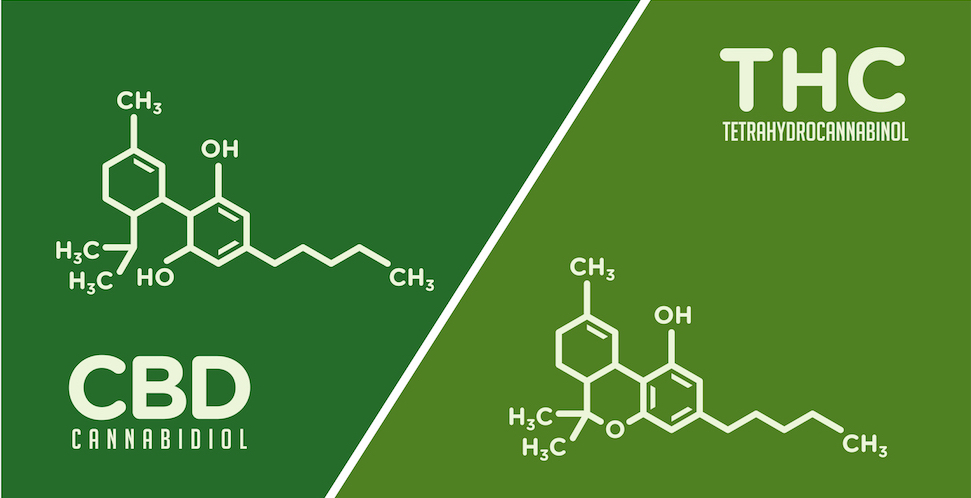
CBD vs. THC for PTSD
CBD is the primary non-psychoactive component of cannabis and has anti-inflammatory, neuroprotective, anxiolytic and antipsychotic actions— it’s different to THC— which produces the mind-altering effects you may commonly hear about, also known as causing a ‘high’.
CBD doesn’t make you ‘high’— hence its popularity as a therapeutic agent.
Another advantage over other agents (such as THC) is CBD has fewer complications at high doses [1].
Research Supports CBD for PTSD
Promising research shows that CBD is effective in attenuating some of the major symptoms of PTSD— such as preventing the consolidation of fear memories, reducing anxiety and improving sleep.
In a recent 2018 review, researchers found that CBD offers a safe, therapeutic alternative for treating PTSD— with significant improvements in these symptoms, particularly in reducing the retention of unpleasant memories [1].
Other research has confirmed that nabilone, a synthetic cannabinoid, is effective in blocking trauma-related nightmares in patients that did not respond to traditional therapies [8].
As acceptance of CBD widens, more countries have approved the use of medical-grade cannabis for the treatment of PTSD. CBD is recognized as a suitable treatment option with its ability to reduce anxiety and depression, improve sleep, and eliminate flashbacks — all without risk of serious side-effects.
What is PTSD?
PTSD is a chronic psychological condition that can develop after experiencing a traumatic event.
You may be wondering if you or someone you care about has PTSD.
Often, people don’t believe they meet the criteria or have the ‘right’ to have PTSD, because it’s regularly associated with first responders and military veterans.
However, PTSD can affect anyone.
What is a Traumatic Event?
Traumatic events can mean experiencing or witnessing life-threatening events that cause intense fear or threat to safety.
Some Examples of Traumatic Events Include:
- Domestic violence or abuse
- Witnessing someone being killed or seriously injured
- Surviving a car/train/bus accident or plane crash
- Surviving a heart attack or receiving a serious medical diagnosis
- Being a victim of rape or sexual assault
- Victim of a crime, kidnapping, stalking or torture
- Experiencing a life-changing event, such as divorce, unemployment or the death of a loved one
- Experiencing a natural disaster like bushfires, earthquakes, floods
- Experience in war or civil conflict or terrorist attack
What Are The Symptoms of PTSD?
People living with PTSD often experience multiple symptoms as the body and mind try to cope with the stressful event.
PTSD can manifest in many ways — developing into anxiety and depression or reckless behavior. Gut issues, migraines, headaches, and reduced immunity are common symptoms associated with PTSD.
Signs & Symptoms of PTSD (According to The Anxiety and Depression Association of America):
- Flashbacks of the trauma
- Physical symptoms (such as racing heartbeat, sweating, brain fog)
- Trouble sleeping
- Overly emotional, mood alterations (such as rage, shame, blame, negativity)
- Emotional detachment
- Negative beliefs and feelings
- Intrusive thoughts and memories
- Hypervigilance/anxiety
- Living in fear
- Nightmares and strange dreams
- Difficulty maintaining employment
- Difficulty concentrating
- Avoidance and Social isolation
- Substance abuse
PTSD symptoms can last between a few months to many years after the event — sometimes leading to chronic illness.
Sufferers often feel like they’re on guard, or something’s always about to go wrong, and they’re left feeling exhausted and in fear — which can continue for many years after the event.
Bodily symptoms of shortness of breath, tremors, increased heart rate, memory loss, and poor concentration can hijack our ability to lead a healthy life.
Risk Factors for PTSD
Anxiety and fear are normal adaptive responses that help us cope with threats to our survival. Not everyone who experiences a traumatic event will develop PTSD, but some factors can influence their likelihood of developing it.
Some risk factors of PTSD include:
- A long-lasting or intense trauma (such as childhood abuse or domestic violence)
- First responders and military personnel where there is greater exposure to traumatic events
- Having existing anxiety and depression
- A family history of anxiety and depression
For survivors of trauma, it can be extremely difficult and frustrating to try to understand the psychological and physical changes occurring — and what can be done to ease them.

How Is PTSD Diagnosed?
A doctor may perform a physical exam and a psychological assessment, using the Diagnostic and Statistical Manual of Mental Disorders (DSM-5).
PTSD is identified by signs and symptoms in the following three categories for a period extending from 1 month [3]:
- Reminders of the Exposure — Flashbacks, nightmares, intrusive thoughts
- Activation — Hyperarousal, agitation, insomnia, irritability, aggression, impulsiveness
- Deactivation — Numbing, isolation, avoidance, confusion, anxiety, depression
How Trauma Affects The Nervous System
The nervous system is a complex system that involves nerves and cells, known as neurons, which transmit signals from the brain to various parts of the body.
When the brain experiences any event that has negative consequences from a stressful or dangerous situation, the hormone adrenaline kicks in via the sympathetic nervous system. This is commonly known as ‘fight or flight’ which is a natural, built-in stress response.
However, in PTSD, the stress response is heightened, and instead of returning to normal soon after the threat is over, it’s pushed beyond its limits, and becomes ‘stuck’.
The nervous system loses its ability to self-regulate, leading to psychological and physical distress.
This state is known as hypervigilance. The body is continuously alert in order to avoid danger. As a result, people can startle easily, have increased sweating, a rapid heartbeat, and quick breathing.
Conventional Treatments for PTSD
Conventional treatment usually involves psychotherapy, and can also include medications, such as antidepressants to improve symptoms.
The Mayo Clinic explains the symptoms, causes, current diagnosis, and treatment to treat both children and adults with PTSD.
Those suffering PTSD symptoms often feel their only option is a life relegated to pharmaceutical drugs and therapy. Medications have their place and can be life-saving — but are often ineffective.
Unfortunately, remission in PTSD patients is relatively low. These medications can also have unwanted side effects [4], including:
- Nausea
- Dry mouth
- Weight gain
- Sexual dysfunction
- Insomnia
- Constipation/diarrhea
- Dizziness
- Headache
- Worsening of depressive symptoms
Opioids are also prescribed to patients with PTSD, however, they’re highly addictive medications and patients with PTSD may be at a higher risk of developing opioid use disorder compared to patients without PTSD.
Thankfully CBD offers a safer treatment option for people with PTSD without the side effects. However, CBD interacts with many medications.
If you’re thinking about trying CBD oil, it’s important you speak with your doctor before stopping other medications.
When combined with conventional treatment, natural therapies can be beneficial in recovery from PTSD in addition to lifestyle modifications such as:
1. Yoga & Meditation
Research has shown yoga improves emotional regulation, heart rate variability and reduces anxiety and stress [5].
2. Good Sleep & Hygiene
Ensure enough quality sleep and rest by adopting healthy sleeping habits. Relaxation exercises and improving your sleeping environment so it feels restful and comfortable will help.
In addition to getting enough sleep, showering and taking good care of your hygiene goes a long way to maintain your mental health.
3. Leverage Social Connection & Close Relationships
Use support networks such as family and friends or organizations in your local area. Depending on where you live, there are likely support groups where you can connect with others who have PTSD. Meetup is another excellent way to bond with like-minded people.

4. Exercise
A natural and inexpensive way to improve mood, appetite, and sleep is by finding an enjoyable way to get movement into your day — even if it’s simply going for a walk, preferably in nature.
5. Eating a Well-balanced & Clean Diet
Limit caffeine and alcohol can decrease anxiety symptoms [6]. A poor diet high in sugar and processed type foods can lead to low mood, fatigue, increased anxiety, and weight gain.
Although PTSD is not curable, it doesn’t have to run your life.
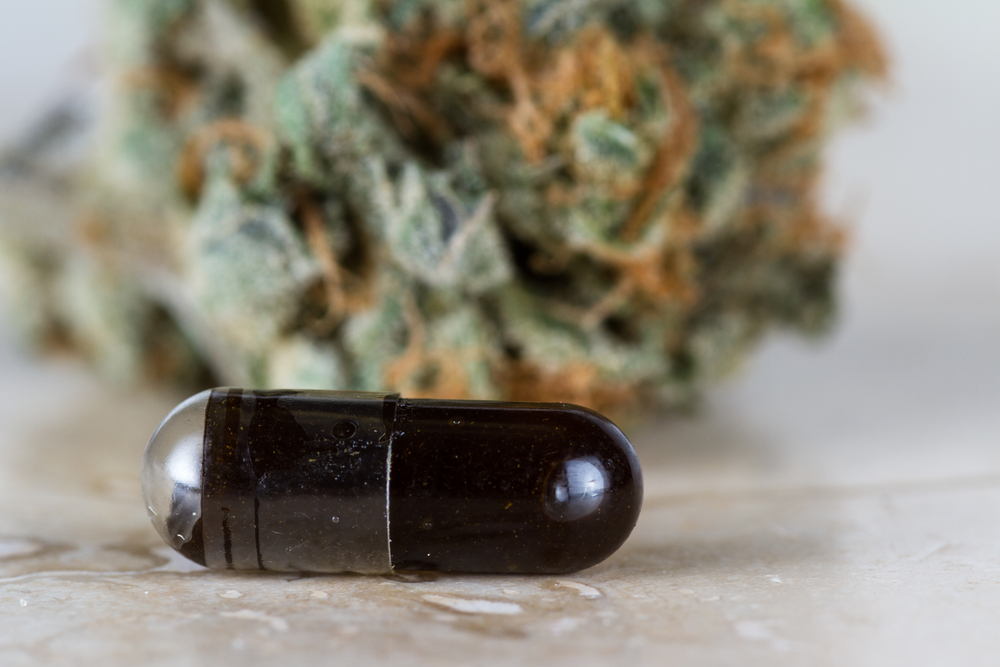
Key Takeaways: Using CBD For PTSD
Living with PTSD can be difficult. There is no cure but there is hope.
Used in addition to therapies, CBD may relieve many of the symptoms related to PTSD — such as anxiety, depression, insomnia, and prevent nightmares and flashbacks.
CBD Oil offers a safe and effective treatment to reduce symptoms and improve quality of life.
References Cited In This Article
- Bitencourt, R. M., & Takahashi, R. N. (2018). Cannabidiol as a therapeutic alternative for post-traumatic stress disorder: From bench research to confirmation in human trials. Frontiers in Neuroscience. Frontiers Media SA. https://doi.org/10.3389/fnins.2018.00502
- Posttraumatic Stress Disorder (PTSD) | Anxiety and Depression Association of America, ADAA. (n.d.). Retrieved November 26, 2018, from https://adaa.org/understanding-anxiety/posttraumatic-stress-disorder-ptsd
- Sherin, J. E., & Nemeroff, C. B. (2011). Post-traumatic stress disorder: the neurobiological impact of psychological trauma. Dialogues in Clinical Neuroscience, 13(3), 263–78. Retrieved from http://www.ncbi.nlm.nih.gov/pubmed/22034143
- Farach, F. J., Pruitt, L. D., Jun, J. J., Jerud, A. B., Zoellner, L. A., & Roy-Byrne, P. P. (2012). Pharmacological treatment of anxiety disorders: current treatments and future directions. Journal of Anxiety Disorders, 26(8), 833–43. https://doi.org/10.1016/j.janxdis.2012.07.009
- Gallegos, A. M., Crean, H. F., Pigeon, W. R., & Heffner, K. L. (2017, December). Meditation and yoga for posttraumatic stress disorder: A meta-analytic review of randomized controlled trials. Clinical Psychology Review. NIH Public Access. https://doi.org/10.1016/j.cpr.2017.10.004
- Rehm, J., Gmel, G. E., Gmel, G., Hasan, O. S. M., Imtiaz, S., Popova, S., … Shuper, P. A. (2017). The relationship between different dimensions of alcohol use and the burden of disease-an update. Addiction (Abingdon, England), 112(6), 968–1001. https://doi.org/10.1111/add.13757
- Fraser, G. A. (2009). The Use of a Synthetic Cannabinoid in the Management of Treatment-Resistant Nightmares in Posttraumatic Stress Disorder (PTSD). CNS Neuroscience & Therapeutics,15(1), 84–88. https://doi.org/10.1111/j.1755-5949.2008.00071.x
- Jetly, R., Heber, A., Fraser, G., & Boisvert, D. (2015). The efficacy of nabilone, a synthetic cannabinoid, in the treatment of PTSD-associated nightmares: A preliminary randomized, double-blind, placebo-controlled cross-over design study. Psychoneuroendocrinology,51, 585–588. https://doi.org/10.1016/j.psyneuen.2014.11.002
- Blessing, E. M., Steenkamp, M. M., Manzanares, J., & Marmar, C. R. (2015, October). Cannabidiol as a Potential Treatment for Anxiety Disorders. Neurotherapeutics. Springer. https://doi.org/10.1007/s13311-015-0387-1
- Russo, E. B., Guy, G. W., & Robson, P. J. (2007, August 1). Cannabis, pain, and sleep: Lessons from therapeutic clinical trials of sativexρ, a cannabis-based medicine. Chemistry and Biodiversity. Wiley-Blackwell. https://doi.org/10.1002/cbdv.200790150
- WHO. (2017). WHO | Cannabidiol (compound of cannabis). WHO. Retrieved from http://www.who.int/features/qa/cannabidiol/en/
More Health Benefits to Explore
-
Conditions Related to Health Benefits
- CBD For Allergies: Can This Cannabinoid Ease Symptoms?
- Top 10 CBD Oils For Back Pain
- Can CBD Help With Menstrual Cramps?
- CBD for Sciatica: How It Works, Safety, Drug Interactions, & Best Products
- Is CBD a Viable Treatment for Cerebral Palsy?
- CBD Oil For Sleep
- CBD For Psoriasis: Can CBD Help to Alleviate Symptoms?
- Traumatic Brain Injury (TBI)
- Arthritis
- Anxiety & Depression
- Weight Loss
- ADD & ADHD
- Anorexia
- Alzheimer’s Disease & Dementia
- Addiction
- ALS (Amyotrophic Lateral Sclerosis)
- Antibiotic Resistance
- Asthma
- Atherosclerosis
- Autism
- Acne
- Bipolar Disorder
- Pain
- Crohn's Disease & Ulcerative Colitis
- Diabetes
- Epilepsy
- Endocrine Disorders
- Fibromyalgia
- Fatty Liver Disease
- Glaucoma
- Hypertension
- Heart Disease
- Huntington's Disease
- Inflammation
- Irritable Bowel Syndrome (IBS)
- Kidney Disease
- Migraine Headaches
- Muscle Recovery
- Multiple Sclerosis
- Motion Sickness
- Metabolic Syndrome
- Neurodegeneration
- Cancer
- Nausea
- Neuropathic (Nerve) Pain
- Osteoporosis/Bone Health
- Obsessive-Compulsive Disorder (OCD)
- Polycystic Ovarian Syndrome (PCOS)
- PTSD
- Prion/Mad Cow Disease
- Premenstrual Syndrome (PMS)
- Parkinson’s Disease
- Schizophrenia
- Sickle Cell Anemia
- Stroke
-
Conditions Related to Products
- Ranking The Top 13 THC Gummies By Category (Δ8, Δ9, Δ10, HHC, & More)
- Top 10 CBD Oils For Back Pain
- Everything You Need to Know About CBD Sunscreen
- Top 7 CBD Gummies For Sleep & Insomnia
- Top 7 CBD Gummies To Help With Anxiety (2022)
- Best CBD Gummies For Pain (Top-Rated Pain Gummies For 2022)
- Best Hemp Cigarettes (Top 5 Nicotine-Free Smokes)
- Top 5 CBD Lip Balms For 2022
- The Top 7 CBD Face Masks for 2022
- The Best CBD Inhalers For 2022 (& How to Use Them)
- Best Full-Spectrum CBD Vape Juice: What to Look For & How to Use It
- CBD Eye Drops: New Option For Glaucoma?
- CBD Oil For Dogs With Arthritis
- Best CBD Massage Oils In 2022
- Buyer's Guide To The Best CBD Vape Kits In 2022
- CBD Chocolate: Yes, It Exists & It's Just as Divine as it Sounds
- CBD Pre-Rolls & Cigarettes
- Terpene Concentrates
- Best CBD Soaps
- Best CBD Shampoo & Conditioner
- Best CBD Juul Pods
- CBD Isolate Oils
- Full-Spectrum CBD Oils
- Best CBD Lube
- CBD Honey
- CBD Transdermal Patches
- Best Dry Herb Vaporizers
- CBD Oil For Dogs With Epilepsy
- CBD Oil For Dogs With Anxiety
- CBD Oil For Dogs With Cancer
- CBD For Horses
- CBD Chewing Gum
- CBD Pain Cream
- CBD Oil For Cats
- CBD Oil For Dogs
- CBD Hemp Flower
- CBD Suppositories
- Best CBD Gummies for Pain, Sleep & Anxiety Reviewed (2022)
- CBD Teas
- CBD Vape Pens
- CBD Vape Oils
- CBD Coffee
- CBD Drinks & Shots
- CBD Crystals
- CBD Skincare
- Best CBD Oil & Gummies For Kids: Is CBD Safe for Children with Anxiety & ADHD?
- CBD Concentrates
- CBD Bath Bombs
- CBD Capsules
- CBD Sprays
- CBD Dog Treats
-
Conditions Related to Topicals
-
Conditions Related to Oils & Tinctures
-
Conditions Related to Edibles
- Top 7 CBD Gummies To Help With Anxiety (2022)
- Best CBD Gummies For Pain (Top-Rated Pain Gummies For 2022)
- CBD Chocolate: Yes, It Exists & It's Just as Divine as it Sounds
- CBD Honey
- CBD Chewing Gum
- Best CBD Gummies for Pain, Sleep & Anxiety Reviewed (2022)
- CBD Teas
- CBD Coffee
- CBD Drinks & Shots
- CBD Capsules
-
Conditions Related to Gummies
- Ranking The Top 13 THC Gummies By Category (Δ8, Δ9, Δ10, HHC, & More)
- Top 7 CBD Gummies For Sleep & Insomnia
- Top 7 CBD Gummies To Help With Anxiety (2022)
- Best CBD Gummies For Pain (Top-Rated Pain Gummies For 2022)
- Best CBD Gummies for Pain, Sleep & Anxiety Reviewed (2022)
- Best CBD Oil & Gummies For Kids: Is CBD Safe for Children with Anxiety & ADHD?
-
Conditions Related to Hemp Flower
-
-
Conditions Related to Terpenes
-
-
Conditions Related to Cultivation
-
Conditions Related to Concentrates
-
Conditions Related to Delta 8 THC
-
Conditions Related to Delta 9 THC
-
-
-
-
Conditions Related to CBD
- Everything You Need to Know About CBD Sunscreen
- Top 7 CBD Gummies For Sleep & Insomnia
- Top 7 CBD Gummies To Help With Anxiety (2022)
- Best CBD Gummies For Pain (Top-Rated Pain Gummies For 2022)
- Best Hemp Cigarettes (Top 5 Nicotine-Free Smokes)
- Top 5 CBD Lip Balms For 2022
- The Top 7 CBD Face Masks for 2022
- The Best CBD Inhalers For 2022 (& How to Use Them)
- Best Full-Spectrum CBD Vape Juice: What to Look For & How to Use It
- CBD Eye Drops: New Option For Glaucoma?
- CBD Oil For Dogs With Arthritis
- Best CBD Massage Oils In 2022
- Buyer's Guide To The Best CBD Vape Kits In 2022
- CBD Chocolate: Yes, It Exists & It's Just as Divine as it Sounds
- CBD Pre-Rolls & Cigarettes
- Best CBD Soaps
- Best CBD Shampoo & Conditioner
- Best CBD Juul Pods
- CBD Isolate Oils
- Full-Spectrum CBD Oils
- Best CBD Lube
- CBD Honey
- CBD Transdermal Patches
- CBD Oil For Dogs With Epilepsy
- CBD Oil For Dogs With Anxiety
- CBD Oil For Dogs With Cancer
- CBD For Horses
- CBD Chewing Gum
- CBD Pain Cream
- CBD Oil For Cats
- CBD Oil For Dogs
- CBD Hemp Flower
- CBD Suppositories
- Best CBD Gummies for Pain, Sleep & Anxiety Reviewed (2022)
- CBD Teas
- CBD Vape Pens
- CBD Vape Oils
- CBD Coffee
- CBD Drinks & Shots
- CBD Crystals
- CBD Skincare
- Best CBD Oil & Gummies For Kids: Is CBD Safe for Children with Anxiety & ADHD?
- CBD Concentrates
- CBD Bath Bombs
- CBD Capsules
- CBD Sprays
- CBD Dog Treats
-
-
Conditions Related to THC-O
-
-
Conditions Related to Joint Health
-
Conditions Related to Pain Disorders
- Top 10 CBD Oils For Back Pain
- Can CBD Help With Menstrual Cramps?
- CBD for Sciatica: How It Works, Safety, Drug Interactions, & Best Products
- Traumatic Brain Injury (TBI)
- Arthritis
- Pain
- Fibromyalgia
- Glaucoma
- Inflammation
- Kidney Disease
- Migraine Headaches
- Multiple Sclerosis
- Neuropathic (Nerve) Pain
- Premenstrual Syndrome (PMS)
- Sickle Cell Anemia
-
Conditions Related to Autoimmune Disease
-
Conditions Related to Cognitive Health
-
Conditions Related to Metabolic Disorders
-
Conditions Related to Psychological Disorders
-
Conditions Related to Muscles & Bones
-
Conditions Related to Nervous System
- CBD for Sciatica: How It Works, Safety, Drug Interactions, & Best Products
- Is CBD a Viable Treatment for Cerebral Palsy?
- CBD Oil For Sleep
- Traumatic Brain Injury (TBI)
- Anxiety & Depression
- ADD & ADHD
- Anorexia
- Alzheimer’s Disease & Dementia
- Addiction
- ALS (Amyotrophic Lateral Sclerosis)
- Autism
- Bipolar Disorder
- Epilepsy
- Huntington's Disease
- Inflammation
- Migraine Headaches
- Multiple Sclerosis
- Motion Sickness
- Neurodegeneration
- Neuropathic (Nerve) Pain
- Obsessive-Compulsive Disorder (OCD)
- PTSD
- Prion/Mad Cow Disease
- Parkinson’s Disease
- Schizophrenia
-
-
Conditions Related to Reproductive Health
-
Conditions Related to Hormones & Endocrine
-
Conditions Related to Skin Health
-
Conditions Related to Cardiovascular System
-
Conditions Related to Digestive System
-
Conditions Related to Genetic Disorders
-
Conditions Related to For Children


